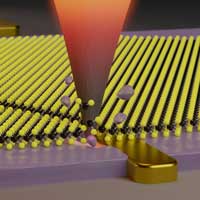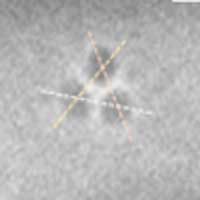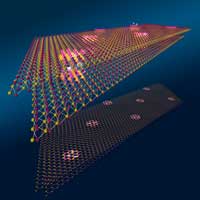 Researchers have developed a high-precision technology that enables them to carve nanometric patterns into two-dimensional materials.
Researchers have developed a high-precision technology that enables them to carve nanometric patterns into two-dimensional materials.
Tuesday, June 23, 2020
Researchers cut nanometer-sized patterns into 2D materials
 Researchers have developed a high-precision technology that enables them to carve nanometric patterns into two-dimensional materials.
Researchers have developed a high-precision technology that enables them to carve nanometric patterns into two-dimensional materials.
Microscopic computers: The wires of the future may be made of molecules
 There are physical limits to how powerful computers can become if they are to maintain their size. Molecular electronics can solve that problem, and now researchers are contributing to this field with a new, efficient conducting material, based on molecules.
There are physical limits to how powerful computers can become if they are to maintain their size. Molecular electronics can solve that problem, and now researchers are contributing to this field with a new, efficient conducting material, based on molecules.
Using chaos as a tool, scientists discover new method of making 3D-heterostructured materials
 Scientists have developed a new approach for generating layered, difficult-to-combine, heterostructured solids.
Scientists have developed a new approach for generating layered, difficult-to-combine, heterostructured solids.
New quantum materials with unique properties
 A new EU project focuses on quantum materials, whose properties can be modified significantly by elastic deformation.
A new EU project focuses on quantum materials, whose properties can be modified significantly by elastic deformation.
Manipulating tiny skyrmions with small electric currents
 Researchers have managed to manipulate and track the movement of individual magnetic vortices called skyrmions, which have been touted as strong candidates to act as information carriers in next-generation storage devices and as synapses for neuromorphic computing.
Researchers have managed to manipulate and track the movement of individual magnetic vortices called skyrmions, which have been touted as strong candidates to act as information carriers in next-generation storage devices and as synapses for neuromorphic computing.
Twisted WSe2 as a highly tunable platform for the study of exotic phenomena
 Researchers report that the twisted bilayer transition metal dichalcogenide WSe2 enables the realization of exotic correlated phenomena, including high-Tc superconductivity and correlated insulators, in a controlled manner and without the geometrical restriction found in twisted bilayer graphene.
Researchers report that the twisted bilayer transition metal dichalcogenide WSe2 enables the realization of exotic correlated phenomena, including high-Tc superconductivity and correlated insulators, in a controlled manner and without the geometrical restriction found in twisted bilayer graphene.
A structural light switch for magnetism
 Scientists have managed to drive a prototypical antiferromagnet into a new magnetic state using terahertz frequency light.
Scientists have managed to drive a prototypical antiferromagnet into a new magnetic state using terahertz frequency light.
'Unboil an egg' machine creates improved bacteria detector
 Traditional fluorescent dyes to examine bacteria viability are toxic and suffer poor photostability - but using the Vortex Fluidic Device has enabled the preparation of a new generation of aggregation-induced emission dye luminogens using graphene oxide.
Traditional fluorescent dyes to examine bacteria viability are toxic and suffer poor photostability - but using the Vortex Fluidic Device has enabled the preparation of a new generation of aggregation-induced emission dye luminogens using graphene oxide.
Subscribe to:
Posts (Atom)
